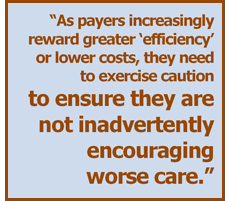Full text is available at:
http://content.healthaffairs.org/cgi/content/full/28/3/897?ijkey=TNmS/.JXdeRXk&keytype=ref&siteid=healthaff
Synopsis
In a study exploring the relationship between cost and quality of care in more than 3,700 U.S. hospitals treating Medicare patients, researchers found that low-cost facilities had modestly lower scores on process-of-care measures for two common medical conditions (acute myodcardial infarction and congestive heart failure) than did high-cost facilities—although risk-adjusted mortality rates were comparable for low- and high-cost hospitals. Certain hospital characteristics were associated with lower costs: being for-profit, having greater numbers of Medicare patients, having shorter average lengths of stay, and employing fewer nurses.
The Issue
The relationship between the risk-adjusted costs of care—often referred to as efficiency—and the quality of care is not well understood. Some experts assume that higher-quality care will necessarily cost more, while others argue that better care will lead to lower costs.
Association Between Risk-Adjusted Cost of Care and Hospital Quality Scores | ||
| Hospital cost quartile (lowest to highest) |
Acute Myocardial Infarction Summary Score (n=2,236) |
Congestive Heart Failure Summary Score (n=2,807) |
| 1 | 88.9 | 77.0 |
| 2 | 90.7 | 82.7 |
| 3 | 90.7 | 82.4 |
| 4 | 90.8 | 81.7 |
| p 0.001 Source: Adapted from A. K. Jha, E. J. Orav, A. Dobson et al., "Measuring Efficiency: The Association of Hospital Costs and Quality of Care," Health Affairs, May/June 2009 28(3):897-906, Exhibit 3. |
Key Findings
- Hospitals that ranked in the bottom 25 percent (quartile) for risk-adjusted costs were more likely than hospitals in the highest quartile to be for-profit (25% vs. 10%). On average, lower-cost hospitals treated more Medicare patients, employed fewer nurses, and had shorter average lengths of stay than hospitals in the highest-cost quartile.
- Compared with the highest-cost hospitals, low-cost hospitals had somewhat lower scores on process-of-care measures for acute myocardial infarction (90.8% vs. 88.9%) and congestive heart failure (81.7% vs. 77.0%).
- There were no consistent relationships found between hospital costs and mortality rates.
Addressing the Problem
 Across U.S. hospitals, the risk-adjusted costs of caring for Medicare patients range widely. Based on the study findings, it is not possible to assume that better care management will necessarily lead to both lower costs and higher-quality care. Certain cost-cutting measures, such as lower nurse staffing levels, may have adverse effects on the quality of care. As efforts are made to control health care costs and reward efficiency, it will be important to ensure that payment policies do not inadvertently promote worse care.
Across U.S. hospitals, the risk-adjusted costs of caring for Medicare patients range widely. Based on the study findings, it is not possible to assume that better care management will necessarily lead to both lower costs and higher-quality care. Certain cost-cutting measures, such as lower nurse staffing levels, may have adverse effects on the quality of care. As efforts are made to control health care costs and reward efficiency, it will be important to ensure that payment policies do not inadvertently promote worse care.
About the Study
The authors used data from the Centers for Medicare and Medicaid Services and the American Hospital Association Annual Survey to examine the relationship between the average risk-adjusted costs of caring for Medicare patients in 3,794 U.S. hospitals and the hospitals' structural characteristics, nursing levels, quality of care, and outcomes. They calculated hospitals' actual average costs per case for Medicare patients, divided by their predicted average costs per case, to organize hospitals into quartiles based on their risk-adjusted hospital costs.
The Bottom Line
As a group, low-cost hospitals appear to provide marginally lower quality of care for two common clinical conditions. Strategies are needed to ensure that care is both high quality and low cost in all hospitals.


